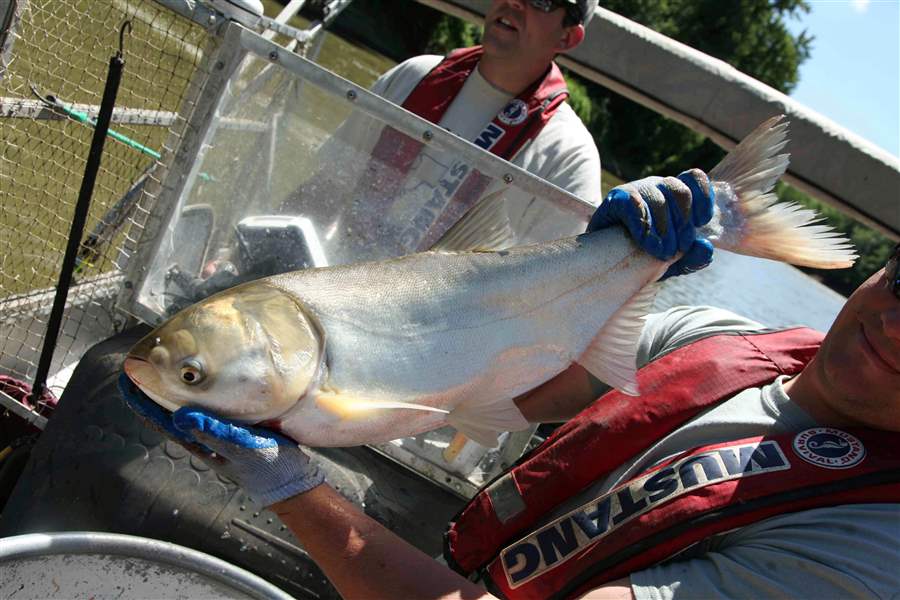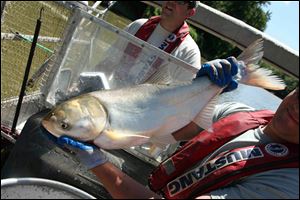
Asian carp alert: Identifying a menace to the Great Lakes
9/30/2012
Travis Schepker, a biology intern, holding an Asian carp pulled from the Illinois River near Havana, Ill. Scientists are monitoring native fish populations for signs of damage from Asian carp.
Associated Press

Travis Schepker, a biology intern, holding an Asian carp pulled from the Illinois River near Havana, Ill. Scientists are monitoring native fish populations for signs of damage from Asian carp.
The most serious threat to the ecological balance in the Great Lakes is posed by a group of unwelcome, strange-looking, slime-heavy visitors from the Far East.
Asian carp.
They comprise a marauding horde that now lays claim to large stretches of the Mississippi River watershed, and driven by instinct, they are pushing at the gates and trying to force their way into one of the world’s largest freshwater reserves — those still great Great Lakes.
The term “Asian carp” is often used to reference four exotic and invasive species — Bighead, Silver, Black, and Grass carp — all native to China.
When the potential peril these fish pose to Lake Erie and the Maumee and Sandusky rivers is discussed, it’s the Bighead and Silver carp that are perceived as the wolves baying at the door.

These fish are filter feeders that gobble up tiny algae and zooplankton in tremendous amounts, upsetting the food column and often forcing out native species. Bighead carp grow to 100 pounds and four feet in length, while Silver carp can reach 60 pounds and three feet long.
Some of these Asian carp can consume nearly half their body weight each day, but given their feeding habits, these fish are rarely caught by conventional hook-and-line methods. They are more often snagged, netted, or in the case of the Silver carp, encountered when they go airborne in reaction to the sound and vibrations produced by outboard motors.
Smallmouth bass jump — Silver carp shoot out of the water, sometimes 10 feet high and often en masse. Many fishermen and recreational boaters have been injured by these hurtling projectiles which average 30 pounds in some rivers.
The Silver carp has a stout body, large head, and huge gill covers. Its snout is rounded and it lacks the barbels or whiskers seen on common carp. The shape of the mouth gives the appearance the fish is frowning.
There are no scales on the head of the Silver carp, and its eyes appear to turn downward. Both species have small scales on the body, but it’s the placement of the eyes that is the telltale marker for Silver and Bighead carp.
“The thing that jumps out the most is the location of the eyes — they are very low-set,” said John Navarro, program administrator for the Ohio Department of Natural Resources. “This is very odd looking when you first see it.”
Besides its color, the Silver carp also can be identified by its spongy-looking gill rakers.
The Bighead carp has the low-set eyes, downward slant to its mouth, and also lacks barbels on its head.
A study by biologists with the U.S. Geological Survey released early this year indicated that, should these carp enter the Great Lakes, the warm and nutrient-rich waters of Lake Erie and the Maumee River would provide them with ideal habitat. The Sandusky River was rated as “moderately suitable” habitat.
The stakes are high in the battle to keep the Asian carp from reaching the Great Lakes watershed and establishing a foothold there. The $7 billion fishing industry is at risk, since the feeding habits of these Asian carp species could starve out the juveniles of native fish and the native plankton-eating fish that provide the bulk of the diet for popular gamefish.